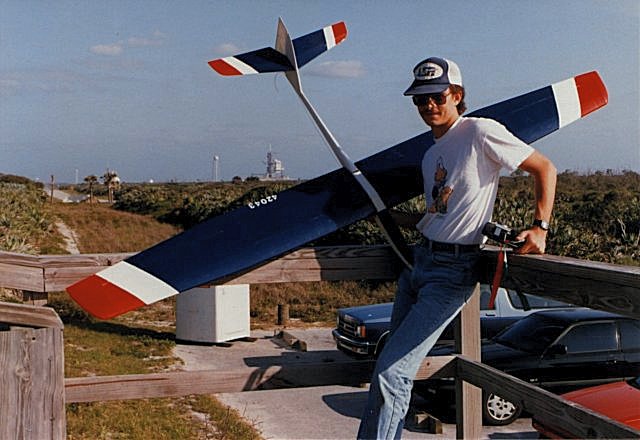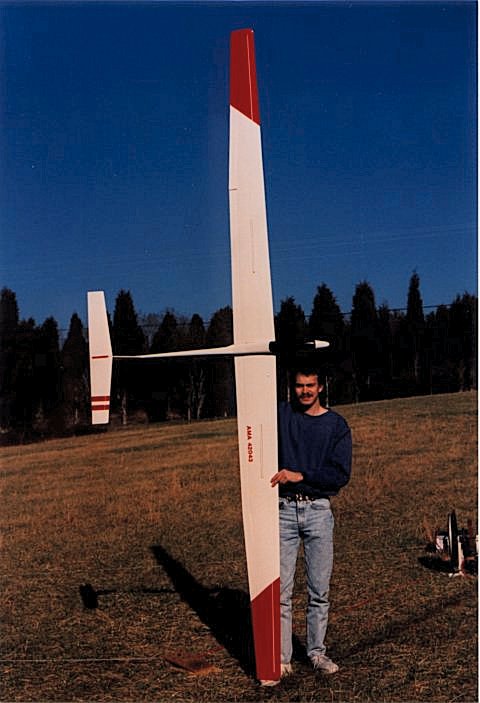I have been building and flying radio-controlled sailplane models since I was 12 years old. I also have been flying power RC models for the past 10 years. Below are examples of some of the models I have modified and scratch-built.

This Sagitta 900 sports a rather unusual control system that uses differential spoilers instead of ailerons for roll control. The sailplane was built in 1985 and still flies to this day. The idea of using differential spoilers for roll control on a sailplane is not widely popular, but has some advantages over ailerons.
Ailerons are the control surfaces that are placed on the trailing edge of the wing, near the wingtips, and cause the sailplane to roll when one aileron is deflected up and the other deflected down. The aileron that deflects upward (with respect to the trailing edge of the wing) causes the lift over that section of the wing to be decreased and that wing drops. In the opposite sense, the aileron that is deflected downward causes lift over that section of the wing to increase and that wing lifts. This causes the sailplane to roll.
A by-product of the aileron deflection is increased drag. It turns out the drag produced by the downward moving aileron is greater than that produced by the upward moving aileron. When ailerons are used alone, the increased drag on the downward moving aileron will cause the sailplane to yaw in the opposite direction from the way it is rolled. This is called adverse yaw and it must be overcome by rudder deflection.
The spoilerons actuate one at a time and cause a simultaneous loss of lift and increase in drag. The result is the sailplane rolls and yaws in the proper direction without the need for excessive rudder deflection. The overall drag produced by control surface deflections is less than that for a conventional aileron and rudder configuration. P.S. Can you guess where the picture was taken?

This glider is my original design created in 1986. The specifics are: wingspan 144 inches, fuselage length 52 inches, airfoil Eppler 214 with flaps, weight 96 oz, controls: rudder, elevator, ailerons, flaps, spoilers, and towhook release. This is the second sailplane of this type that I have created. The first was similar in size and used the Eppler 193 airfoil with flaps. The wings are constructed of a white styrofoam core with 1/16 balsa sheeting and the fuselage is built up with lite-ply (poplar plywood) and balsa, much like the Aquila and Sagitta fuselage construction methods.
Flight performance is very good for a plane of this size. Flaps allow the plane to slow down nicely for landing, and the spoilers are effective in getting it down from high altitudes. The ailerons and rudder are mechanically coupled and driven by a single servo in the center of the fuselage just behind the wing spar. The control system arrangement is much like the Dodgson Designs Camano. The horizontal stabilizer is full-flying and the towhook is mechanically coupled to the spoilers. I believe I liked the E-193 wings better than the E-214 wings, although each has their own advantages and disadvantages. The basic design is sound and would make a good candidate for updated construction and control methods, for example using fiberglass or carbon sheeted high-density foam wings and a molded fiberglass or carbon fuselage. Individual servos could be used with a computer radio to allow fine control of aileron and rudder mixing, flap and elevator mixing, etc.

This model is from a Carl Goldberg Anniversary Edition Piper J-3 Cub kit. The 72 inch wingspan model has several scale modifications, including a leaf spring (CB Associates) tailwheel, brazed 4130 steel landing gear with scale Du-Bro Cub wheels (highly recommended!), scale gas gage, scale jury struts, scale size ailerons, and rigging wires. The model has approximately 200 flights and is powered by an OS .48 Surpass 4-stroke engine. It is a very fun airplane to fly and quite realistic with the 4-stroke engine!
The latest modification has been to replace the OS .48 Surpass with an electric motor. I installed an E-Flite Power 60 motor, a Castle Creations Phoenix 60 Amp speed control, a 14.7 Volt 3350 mAh Li-Po battery, and an APC 15x8 e-prop. This combination seems to work well, yielding an impressive 3.7 lbs static thrust at over 4000 RPM with a fully-charged battery. The performance is scale-like, with reasonable takeoff distances, adequate power for scale aerobatics (loops, spins, wing-overs, and snap-rolls), and enough battery capacity for 20+ minutes of flying. My latest adventure was to install a Flip HD video camera inside the cockpit and shoot some video from some recent flights. Check them out here and here.
Visit Ed's RC Models links page.
Also visit Ed's Electric 'Park Flyers' Models page.
ALL CONTENT ©EDWARD DUMAS. USE WITHOUT PERMISSION PROHIBITED!"